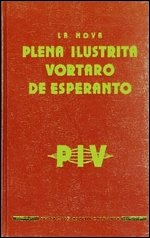Издатель: Sennacieca Asocio Tutmonda
Год выпуска: 2002
Количество страниц: 1265
ISBN: 978-2-9502432-5-6
Язык: Эсперанто (одноязычный словарь) Tiu-cxi unulingva vortaro estas sendube la plej bonkvalita libro iam skribita Esperante. "NPIV", the Nova Plena Ilustrita Vortaro de Esperanto, is the latest, third, incaation of the Plena Ilustrita Vortaro de Esperanto, what has been, since around 1970, generally taken as the canonical dictionary of Esperanto. It finally made it to the market in July, and I got my copy a couple of weeks ago. Herewith a short description — not a review; I haven't read the book, and don't intend to — it's primarily for dipping into when you want to find out what a word means.
The original PIV appeared in 1970, edited by the late Gaston Waringhien. In the middle 1980s a new version appeared — essentially the old edition but with an additional supplement (put together by Waringhien and Roland Levreaud) included at the end. Around the time Waringhien passed away, at the beginning of the nineties, the publisher, SAT, decided to completely redo the dictionary, and tapped a somewhat reluctant Michel Duc Goninaz to step into Waringhien's shoes.
Duc Goninaz, a sometime professor of Slavic languages who, although he is French, is perhaps less Francocentric than was Waringhien, has taken a somewhat different tack in his approach to Esperanto. A certain degree of Westeization of Esperanto that led to a degree of desystemization in the older version of the dictionary seems to have been rolled back; for instance (and perhaps most obviously) Duc Goninaz has done away with the principle (espoused by Kalocsay and the lexicographer Waringhien, though not, as he points out, by the poet Waringhien) of showing a woman's name with a final -A, as opposed to a man's name; -A, insists Duc Goninaz, is the adjective ending, not a feminizing morpheme (pp. 22-23). He does accept that the -A can be used in some cases (where the name is essentially an adjective) as the ending of a name, but no less for men than for women."
Год выпуска: 2002
Количество страниц: 1265
ISBN: 978-2-9502432-5-6
Язык: Эсперанто (одноязычный словарь) Tiu-cxi unulingva vortaro estas sendube la plej bonkvalita libro iam skribita Esperante. "NPIV", the Nova Plena Ilustrita Vortaro de Esperanto, is the latest, third, incaation of the Plena Ilustrita Vortaro de Esperanto, what has been, since around 1970, generally taken as the canonical dictionary of Esperanto. It finally made it to the market in July, and I got my copy a couple of weeks ago. Herewith a short description — not a review; I haven't read the book, and don't intend to — it's primarily for dipping into when you want to find out what a word means.
The original PIV appeared in 1970, edited by the late Gaston Waringhien. In the middle 1980s a new version appeared — essentially the old edition but with an additional supplement (put together by Waringhien and Roland Levreaud) included at the end. Around the time Waringhien passed away, at the beginning of the nineties, the publisher, SAT, decided to completely redo the dictionary, and tapped a somewhat reluctant Michel Duc Goninaz to step into Waringhien's shoes.
Duc Goninaz, a sometime professor of Slavic languages who, although he is French, is perhaps less Francocentric than was Waringhien, has taken a somewhat different tack in his approach to Esperanto. A certain degree of Westeization of Esperanto that led to a degree of desystemization in the older version of the dictionary seems to have been rolled back; for instance (and perhaps most obviously) Duc Goninaz has done away with the principle (espoused by Kalocsay and the lexicographer Waringhien, though not, as he points out, by the poet Waringhien) of showing a woman's name with a final -A, as opposed to a man's name; -A, insists Duc Goninaz, is the adjective ending, not a feminizing morpheme (pp. 22-23). He does accept that the -A can be used in some cases (where the name is essentially an adjective) as the ending of a name, but no less for men than for women."

